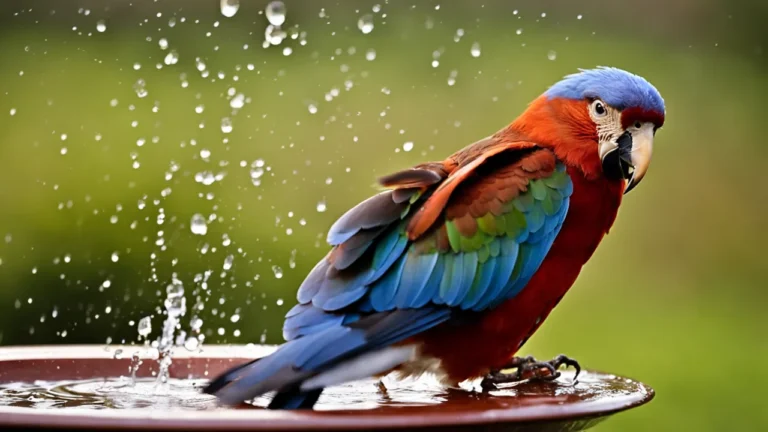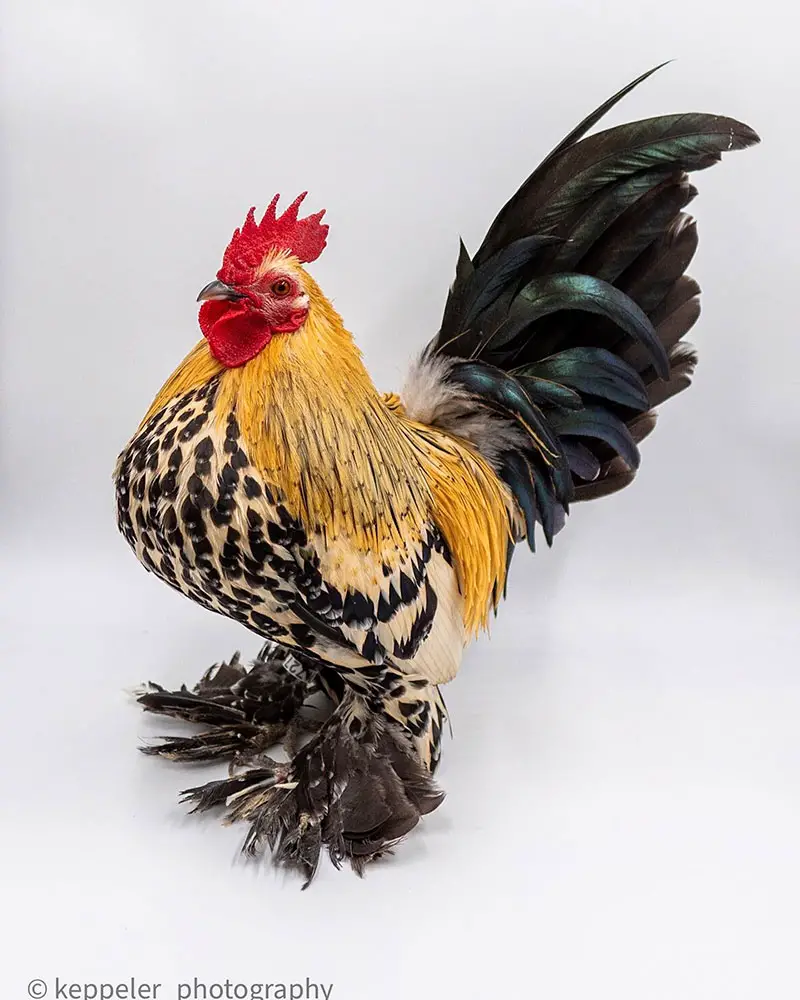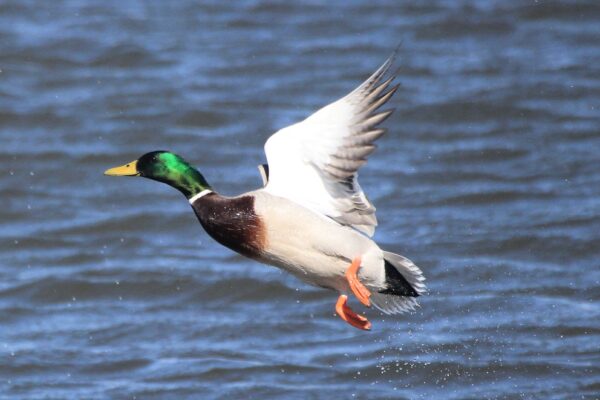Naturally, concerns arise when one witnesses birds preening their wet feathers after a downpour or splashing in a birdbath. Can they still take off and fly over the heavens with their wings soaked? Or do they become grounded by the weight of wetness on their feathers?
This is a simple response in case you’re pressed for time: Because they have unique feather structures and enough flapping force to offset the extra weight, most birds can still fly normally even when their wings are wet.
Water-Resistant Feather Adaptations
Birds are able to fly even when their wings are wet because they have developed a number of adaptations to keep their feathers dry. For birds that live in moist settings or depend on diving into the water to get their food, these adaptations are essential.
Preen oil waterproofing and interlocking barbicels are two important feather adaptations for water resistance.
Barbicels that Interlock
Tiny hook-like structures called interlocking barbicels are present on the barbs of a bird’s flying feathers. These structures are essential for maintaining the interlocking and alignment of the feathers, which contributes to the smooth and aerodynamic surface.
A bird meticulously aligns its barbicels with its beak while preening to make sure they connect correctly. The bird can continue to fly in rainy weather because of this interlocking system, which helps to keep water from seeping through the feathers and onto the bird’s skin.
Waterproofing using Preen Oil
Birds not only create interlocking barbicels but also a specific oil known as preen oil. A gland close to the base of a bird’s tail feathers secretes preen oil. A bird uses its beak to distribute the preen oil throughout its feathers as it preens.
By covering the feathers and keeping water out, this oil acts as a natural waterproofing agent. Preen oil creates a barrier that keeps water out of the feathers, keeping them from becoming heavy.
This allows the bird to continue flying effectively even in the presence of water on its wings.
Were you aware? Ducks and geese are two examples of birds with a large number of preen oil glands. Because of this, they are able to manufacture more oil, which improves the waterproofness of their feathers. These birds are often seen thoroughly grooming themselves to maintain the best possible condition for their feathers.
Visit the All About Birds website for further details on the adaptations of bird feathers for flight, as well as extensive resources on bird biology and behavior.
Moisture’s Effect on Flight Physics
Moisture has the potential to significantly affect the mechanics of flying in birds. A bird’s weight, drag, and lift may all be impacted by wet wings, which can change the aerodynamics of flight.
Let us examine more closely how moisture affects a bird’s capacity to soar.
Elevated Mass and Drag
The additional weight of the water causes a bird’s wet wings to grow heavier. A bird may find it harder to produce the lift required to remain in the air due to its greater weight. Furthermore, damp feathers have the potential to increase drag—the resistance an item experiences while passing through a fluid, like air.
The additional drag may make it more difficult for a bird to fly steadily.
According to Cornell Lab of Ornithology research, a bird’s weight might rise by up to 10% if its feathers are moist. Because of the extra weight, flying may become more energetically taxing for birds, as they must work harder to overcome the increased drag and maintain their flight.
Lift Necessary Adjustments
Birds have to modify their flying mechanics to counteract the extra weight and drag resulting from wet wings. They change the form and location of their wings as one method of doing this. Birds may produce greater lift and offset the extra weight by changing the angle of their wings.
To create greater surface area and produce more lift, they could also stretch their wings broader.
In order to retain the same amount of lift, birds with wet wings may also need to flap them more often. The bird has to waste more energy flapping more, which makes flight with wet wings more taxing.
Although it is difficult for birds to fly when their wings are wet, they have developed to deal with these circumstances. Specialized feathers on birds aid in their ability to resist water and limit excessive absorption. Additionally, they have a preen gland that secretes oils that birds utilize to waterproof and maintain the health of their feathers.
Gaining knowledge about the impact of moisture on the mechanics of flying will help us better understand the behavior and adaptations of birds. It serves as a reminder of the amazing adaptability of birds to survive in a variety of environmental settings.
Birds’ Aeronautic and Muscular Abilities
Birds are remarkably strong and avian, allowing them to fly through the air effortlessly, even in difficult circumstances. Their distinctive wing architecture and strong chest muscles allow them to fly with efficiency.
Strong Muscles in the Chest
The powerful pectoral muscles of birds are what provide them with the thrust required for flight. These muscles provide birds the strength they need to flap their wings by attaching to the keel, a noticeable ridge on their sternum.
These muscles contract and release quickly, giving birds the lift and propulsion they need to remain in the air.
Indeed, certain birds, like hawks and falcons, have quite powerful pectoral muscles. These allow these birds to hunt or avoid predators by enabling them to attain remarkable speeds and perform swift movements.
Because of the power of their chest muscles, they can continue to fly even in difficult situations, as when their wings are wet.
Advantages of Maneuvrability
Birds’ ability to move in flight is further facilitated by their distinctive wing structure. Their feathers’ elasticity and wing shape enable for fine control and modifications while they are in flight.
This makes it possible for birds to execute complex aerial manoeuvres including sharp spins, dives, and abrupt direction changes.
Moreover, birds may modify the angle at which their wings are spread and the location of their feathers, both of which enhance their capacity to fly. Because of their capacity to adapt, birds are able to stay stable in a variety of weather situations and overcome obstacles like damp wings.
According to studies, several bird species can even shake off moisture from their feathers to lessen the detrimental impact that wet wings have on their ability to fly. This action, referred to as “wing flicking,” comprises quick wing motions that aid in removing extra water and restoring the aerodynamic characteristics of the wing.
Notable Exclusions and Weaknesses
Waterlogging in Birds of Prey
Even while birds have amazing flying skills, several species have trouble with damp wings. Feathers of aquatic birds—like ducks, swans, and geese—are uniquely suited to keep them dry and resist water.
A gland close to the base of the tail secretes “preen oil,” a waterproofing material that coats these feathers. By keeping water from penetrating through and weighting the bird down, this oil aids in maintaining the integrity of the feathers.
But aquatic birds may still have problems if their wings get wet, even with their waterproof feathers. When feathers become too wet, they become heavy and lose their capacity to provide lift, a phenomenon known as waterlogging.
This may make it harder for these birds to launch themselves from the water’s surface.
Waterlogging may, under severe circumstances, cause a phenomena called “drowning flight.” This happens when a bird struggles and even drowns because its wings are so soaked that they can no longer hold its weight.
This susceptibility emphasizes how crucial it is for aquatic birds to keep their feathers dry, particularly when they are diving into the water or during periods of intense downpour.
Hummingbirds Acquiring Flight
A noteworthy exception from the general rule that birds cannot fly with wet wings occurs when fledglings, or young birds who have just left the nest and are still learning to fly, are seen. The flying feathers of fledglings are still growing and are not completely waterproof.
Because of this, if their wings become wet, they could find it difficult to provide the lift required for prolonged flight.
Fledglings depend on their ability to make brief flights to develop strength and coordination during this critical learning period. These flights may be more difficult and carry a higher risk of mishaps or injury if the wings are wet.
Therefore, until their flying feathers have completely matured and become waterproof, fledglings should avoid getting their wings wet.
While some birds may find it difficult to fly with wet wings, several species have developed defense mechanisms that enable them to avoid these risks. Some birds, for instance, may shake or ruffle their feathers to get rid of extra water and make their wings more aerodynamic.
Furthermore, certain bird species have evolved special wing forms and flying maneuvers to aid in their more effective navigation of damp or rainy environments.
You may find a wealth of knowledge and resources on websites like Audubon or All on Birds on the aerodynamics of birds and their capacity to fly with wet wings.
Final Thoughts
The majority of healthy birds can fly with wet wings despite the fact that moisture may reduce takeoff and flying efficiency due to feather adaptations and sufficient flapping force. Aquatic birds and young fledglings, on the other hand, are exceptions that need more research.






One thought on “Can Birds Fly With Wet Wings? Explained”